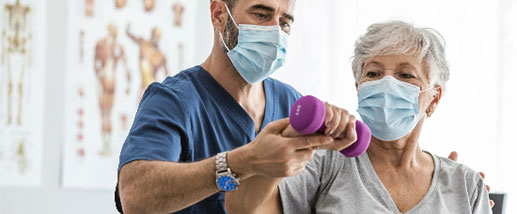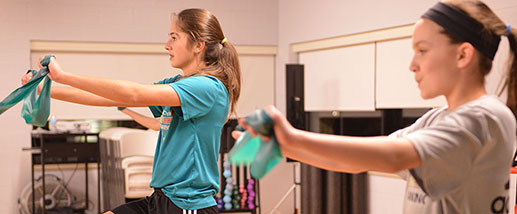Stroke patient urges others to take control of their lives and health care
 It’s a sunny Thursday morning in May, and Sondrea Petrie is on her way to visit her first patient of the day.
It’s a sunny Thursday morning in May, and Sondrea Petrie is on her way to visit her first patient of the day.
A paramedic for 13 years, Petrie has swapped a Pro Med ambulance for an SUV, as she delivers short-term, follow-up medical care to stroke and trauma patients who have been discharged from hospitals and other facilities, and are now at home.
Petrie is one of three team members who has received specialized training beyond their paramedic licensure as part of a program called Community Paramedic. Melissa Carskadon, lead medic, Anthony Pantaleo, operations manager and Pro Med educator, and Petrie have piloted this program since June 2016. Together they have served more than 260 patients, 190 of whom have experienced a stroke or TIA (transient ischemic attack). All stroke and trauma patients are eligible for this in-home follow-up care.
Today Petrie is visiting Chris Lewis, a 48-year-old man who suffered a severe stroke with edema (brain swelling) on Christmas Eve in 2017. He laid on the floor of his apartment for six hours before he was discovered. He suffered a “middle cerebral artery embolic stroke with edema causing brain shift.”
Petrie explains, “My job involves part medical assessment, part needs assessment and part social work. We do everything we can to keep our patients healthy at home so they don’t need to return to the hospital or an emergency department. Our program is one of 12 pilot programs in the state of Michigan, and we serve patients in Muskegon, Oceana, Western Newaygo and Ottawa Counties.”
She pulls up to an apartment development, exits her vehicle, and is greeted at the door by the patient’s mother and caretaker, Margaret Lewis. Hugs and smiles are exchanged.
Margaret leads her upstairs to see Chris, who is just waking up. The room is filled with medical equipment and a pill box with 21 compartments. Chris is not only recovering from a stroke, but he has high blood pressure and is diabetic. On this morning, his blood sugar and blood pressure are normal.
Petrie asks how he’s doing. “I’m doing good,” he says. “Every day I get stronger.” Chris has a strong, optimistic spirit that is unwavering.
Margaret mentions how her son’s three appointments the day before have left Chris exhausted. One of the questions she has for Petrie is about confirming Chris’ disability, and Petrie has already contacted one of the many community organizations she works with to get patients the help they need.
“Here is the number to Pathways,” she says, “and I suggest you give them a call today. They know the ins and outs of disability.”
During her visits, Petrie not only checks Chris’ vitals, but she offers help with managing his medication, does a home safety check, serves as a liaison between him and his primary care provider and even helps to find new housing.
“If we don’t know the answer, we find the answer,” she says. It’s all part of the job she loves.
On one occasion, Chris and Margaret were at the pharmacy, and there was a glitch with the pharmacist filling all of the medications Chris needed.
“Out of the blue, Sondrea called us just to see how we’re doing, and I handed my phone to the pharmacist so she could explain that we need all of his medication,” said Margaret. “We left the pharmacy with everything Chris needed. Sondrea does that…she calls just to check in to see if we need anything. She’s on Chris’ case 110 percent. A lot of times people don’t have family members to help them facilitate things. That’s what Sondrea does.”
Although reducing the number of ED and hospital readmissions is one of the goals of the Community Paramedic program, the team places patient safety first. At one point, Petrie called for an ambulance because Chris’ blood pressure and blood sugar were life-threateningly high.
Dedicated to her patients, Petrie has been caring for Chris since February, which is somewhat unusual. Typically the team cares for a patient for about a month. Chris’ case is more complex.
“Because we’re operating under a special study for the state, we can visit as often and for as long as the patient needs. We cater to what the patient needs. Unique cases, like Chris’, require longer,” says Petrie.
Chris underwent two surgeries, both of which were performed by Christopher Marquart, MD (include full title). The first was an “emergent decompressive craniectomy” to alleviate swelling and prevent herniation (brain shift). A large bone flap from Chris’ skull was removed and preserved in a freezer to be replaced at a later date. He recovered in the Intensive Care Unit and went to rehabilitation at Hackley Campus Mary Free Bed.
“I received excellent care in the hospital,” says Chris. ” And Sondrea, she gets things done that I can’t get done. She’s great.”
Three months later — when the swelling in his brain had gone down — Marquart performed a second surgery to replace the bone flap of Chris’ skull. Following discharge, Chris continued and still goes to rehabilitation at Norton Rehabilitation.
The road to Chris’ recovery has been difficult. “I can’t read yet, and not being able to dictate my own business is something I’m not used to,” he shares.
“I’m an example for other people. I am still here because I have walked a certain spiritual path in my life, with holistic diet, yoga, meditation, staying physically fit, and living off Mother Earth. I’m filled with a flaming fire. You need to take control of your life and recognize that there is something more powerful than you.”
Margaret and Sondrea smile and agree, knowing that this courageous man’s story is a beacon for others.












